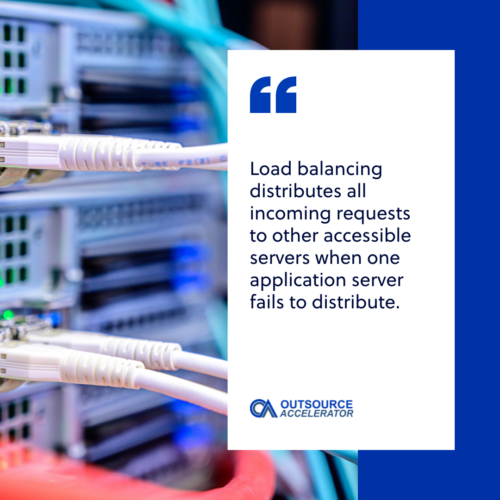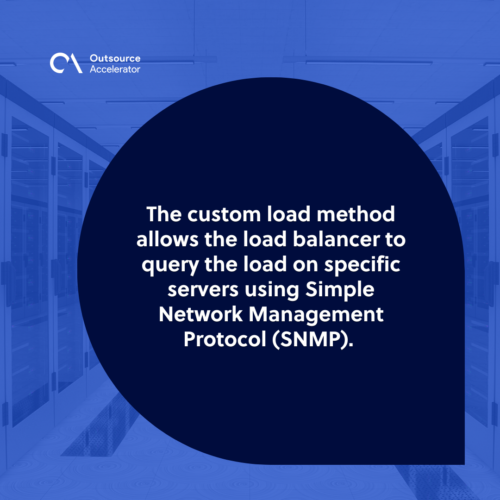Load balancing
Definition
What is load balancing?
Load balancing is the technique of distributing network traffic among various servers. This guarantees that no single server is overloaded as this enhances application responsiveness by equally distributing work. It also improves the accessibility of programs and websites for users.
How does load balancing work?
Load balancing distributes all incoming requests to other accessible servers when one application server fails to distribute.
It can be provided by hardware or software appliances and adds additional load balancing units to handle more volumes. Hardware appliances frequently run commercial systems that have been designed to operate on specialized custom processors.

Why is load balancing necessary?
Load balancing capabilities benefit IT teams in ensuring service performance and reliability.
Its complete and thorough traffic management capability can enable a business to more efficiently routing requests to the appropriate resources for each end-user.
Predictive analytics, which detects traffic bottlenecks before they occur, is one of the benefits of the load balancing method. It provides useful data to a business and is crucial to automation and can improve and strengthen corporate decision-making.
What are the common load-balancing algorithms?
There are various load balancing algorithms, such as:
Round robin
Round robin is one of the simple approaches for ensuring that each client request is routed to a new server from a rotating list by a virtual server. Most helpful when all servers have the same specifications and there aren’t a lot of persistent connections.
It is simple to construct load balancers, but it does not take into consideration the existing demand on a server. There is a risk that a server will get overwhelmed if it receives a significant number of processor-intensive queries.
Least connection method
The technique with the fewest active connections directs traffic to the server with the fewest active connections. This became useful since there are a significant number of persistent connections in the traffic that is unevenly distributed among the servers.
Virtual servers that use the least connection technique will attempt to forward requests to the server with the fewest active connections.
Least response time method
The least response time method indicates how active the server is and the overall expected user experience. Some load balancers will also consider the number of active connections on each server.
Least bandwidth method
The least bandwidth method analyzes activity in megabits per second (Mbps) and delivers client requests to the server with the shortest Mbps volume traffic.
Hashing Method
The hash method bases its choices on a hash of diverse data from the incoming packet. This contains connection or header information from the inbound packet, such as the source or destination IP address, port number, URL, or domain name.
Custom load method
The custom load method allows the load balancer to query the load on specific servers using Simple Network Management Protocol (SNMP).
The administrator may set the server load of interest to queries such as CPU utilization, memory, and average response time and then combine them to meet their needs.

What are the types of load balancing?
There are various types of load balancing including DNS load balancing, hardware-based load balancing, and software-based load balancing.
DNS load balancing
The most common method for load balancing is DNS load balancing. It manages traffic instead of having specialized hardware for determining which server to redirect towards the system.
It maintains a list of IP addresses that correspond to the various servers to which traffic can be directed. It delivers this list of IP addresses and adjusts the order of the addresses every time and asks for a certain domain.
The rearranging of a server is carried out in a round-robin method. Each new request is sent to a different computer in this method as the load is spread across various servers.
The most common use for this method of load balancing is to distribute traffic over various data centers. It is also chosen by businesses since it is a cost-effective and simple-to-implement solution.
Hardware-based load balancing
The distribution of traffic is handled through hardware-based load balancing. These are high-performance hardware that considers the number of open connections, and various criteria when deciding where to route data.
Having specialized hardware to handle load balancing is quite efficient. It is also efficient since a specialized machine is in charge of analyzing load distribution and the flow is quick.
It also provides enhanced security because physical access to the hardware can be restricted by the organization.
Software-based load balancing
The method of establishing load balancing programs on low-cost equipment and virtual machines is known as software-based load balancing. They can also be readily supplied and updated. In addition, they are less expensive and offer greater flexibility than hardware.
Further, it is adaptable and offers various setup possibilities. Traffic balancing may be configured based on various characteristics such as cookies, memory consumption, and network load.
Software-based load balancing may also go beyond its initial capacity by simply adding more VM-based instances to the server.







 Independent
Independent




